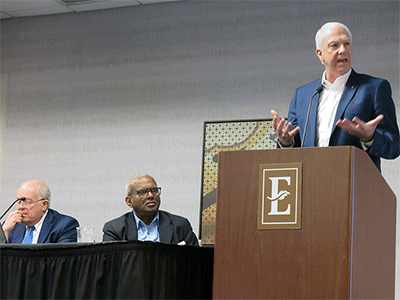The United Methodist Church will look and operate very differently going forward.
That was the frequent refrain at a May 2023 meeting that saw the denomination’s financial leaders shrink an already record-low proposal for the denominational budget in the wake of new projected losses from church disaffiliations and closures. The leaders also heard input on reducing the number of United Methodist bishops.
Yet even while grieving the departures, the leaders also discussed The United Methodist Church’s opportunities to revitalize and share God’s love with renewed vigor.
The GCFA board now is proposing a 2025-2028 denominational budget of about $370.5 million to next year’s General Conference, the denomination’s top policymaking assembly. That’s about $3 million less than the budget the finance agency began working on last fall.
Your support of The General Administration Fund apportionment implements trustworthy administrative oversight like the General Conference sessions.
The new bottom line also marks a nearly 40% reduction.
The proposal requires significant cuts to all funds that support denomination-wide ministries — including United Methodist general agencies and bishops.
It also will be the lowest budget to come before General Conference since 1984, when the international denomination had far fewer members on the African continent and had yet to establish Africa University, now supported with denominational funds.

Figuring out how to manage such steep reductions and maintain vital ministry around the globe has been a source of tension between the GCFA and Connectional Table directors.
However, after months of negotiations, the two groups on May 18 each unanimously approved recommendations on how to divvy up a much-smaller budget.
Both the GCFA board and Connectional Table have long agreed the denomination-wide budget should be significantly reduced. But they differed on how low to go while still sustaining ministries at all levels of the denomination.
This year is likely to see the peak of church disaffiliations under a church law that allows congregations to leave with property if they meet certain conditions. That law is set to expire at the end of 2023.
So far, annual conferences have approved 3,838 disaffiliations — representing a loss of about 12.5% of U.S. congregations since the church law took effect in 2019. Put another way: The majority of U.S. United Methodist churches appear to be remaining in the fold.
It is also unclear how much membership loss these departures will represent since a number of members of exiting congregations are opting to remain United Methodist by transferring to other churches or planting new United Methodist faith communities.
Still, the denomination’s bishops, agency staff and other church leaders are already adjusting to a new reality since before the pandemic.
Bishops, too, are trying to shore up the long-shaky Episcopal Fund, the apportionment-supported fund that enables their work.
Bickerton said he and his episcopal colleagues recognize this challenge.
Between 2024 and 2028, he said, denominational leaders will need to think strategically about where bishops can best serve and are most needed. Simply removing bishops from U.S. areas with high numbers of disaffiliations may be counterproductive in reaching the new mission field.
excerpt from a story by Heather Hahn, assistant news editor, UMNS
One of seven apportioned giving opportunities of The United Methodist Church, the General Administration Fund implements trustworthy administrative oversight, supports the legislative processes of the church and curates The United Methodist Church’s rich history. Please encourage your leaders and congregations to support the General Administration Fund apportionment at 100 percent.





